Approach for Designing Human-Centered and Energy Saving Lighting Luminaires
Abstract
1. Introduction
2. Theoretical Analysis
2.1. Maximum Retina Admissible Exposure Limit (t)
2.2. Action Spectrum of MLT Suppression
2.3. Light Quality Index—SRI & CRI
- Measure the chromaticity coordinates of the given light source on the CIE-1960 color space.
- From the color coordinates, find the closest point on the black-body’s radiation path to determine its correlated color temperature (CCT).
- Selection of reference light source: If the correlated color temperature is less than 5000 K, then assume black-body-radiation as the reference light source. If the correlated color temperature is greater than 5000 K, then CIE standard light source (daylight) can act as a reference light source.
- To irradiate the standard test pieces: The first eight specimens of the reference light source and the given light source are irradiated to find the light color coordinates of the test pieces on CIE-1960.
- Calculate CRI: Calculate the average light color difference according to the eight light color coordinates measured above. If eight light color coordinates reflected from the given light source are reflected with the eight lights from the reference light source, the light color coordinates are the same, and the average light color difference is zero, then the CRI would be100 [48,49].
2.4. Theoretical Efficiency Limit
3. Definition—Pseudo-Sunlight and Anti-Pseudo-Sunlight
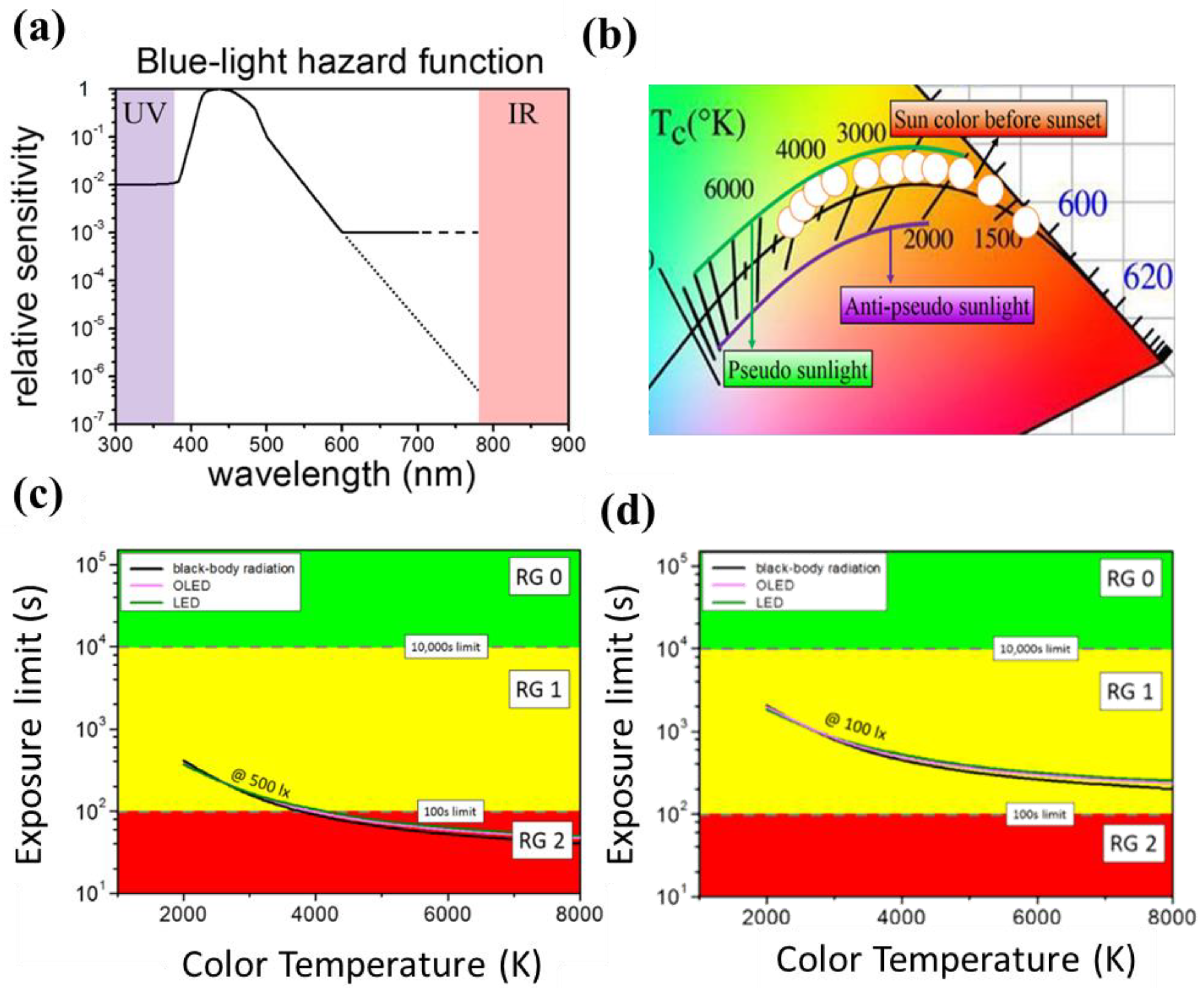
4. Results and Discussion
4.1. Design of Human-Friendly Light Sources
4.1.1. From the Perspective of Retina Protection
Bandwidth Effect
Spectrum Range Effects on Exposure Limit
Natural Light Style Effect
4.1.2. From the Perspective of Melatonin Generation
Effect of Lighting Technology
Spectrum Range Effects on MLT Suppression
Color Effects of Lighting Technology
4.2. Design of Quality Light Sources
4.2.1. From the Perspective of SRI
Effect of Lighting Technology
Spectrum Range Effects on the SRI of Black-Body-Radiation
Color Effects of Lighting Technology on SRI
4.2.2. From the Perspective of CRI
Effect of Lighting Technology on CRI
Spectrum Range Effect on the CRI of Black-Body-Radiation
Color Effects of Lighting Technology on CRI
4.3. Design of Energy-Efficient Light Sources
4.3.1. Effect of Lighting Technology on Efficacy Limit
4.3.2. Spectrum Range Effect on the Efficacy Limit of Black-Body-Radiation
4.3.3. Color Effects of Lighting Technology on Efficacy Limit
5. Conclusions
Supplementary Materials
Author Contributions
Funding
Institutional Review Board Statement
Informed Consent Statement
Data Availability Statement
Conflicts of Interest
References
- Jou, J.H.; Wu, M.H.; Shen, S.M.; Wang, H.C.; Chen, S.Z.; Chen, S.H.; Lin, C.R.; Hsieh, Y.L. Sunlight-style color-temperature tunable organic light-emitting diode. Appl. Phys. Lett. 2009, 95, 013307. [Google Scholar] [CrossRef]
- Jou, J.; Swayamprabha, S.S.; Yadav, R.A.K.; Dubey, D.K. Nano-Structures Enabling Sunlight and Candlelight-Style OLEDs. J. Nanomater. Mol. Nanotechnol. 2018, 7, 1–5. [Google Scholar] [CrossRef]
- IEA “Topics”. Available online:https://www.iea.org/topics/energyefficiency/subtopics/lighting/ (accessed on 15 January 2022).
- Solid State Lighting R&D Plan June 2016, Department of Energy. Available online: https://www.energy.gov/eere/ssl/downloads/solid-state-lighting-2016-rd-plan (accessed on 15 January 2022).
- Kido, J.; Kimura, M.; Nagai, K. Multilayer white light-emitting organic electroluminescent device. Science 1995, 267, 1332. [Google Scholar] [CrossRef] [PubMed]
- Analysing AMOLED Power Efficiency Improvements. Available online: http://www.anandtech.com/show/9394/analysing-amoled-power-efficiency (accessed on 28 December 2021).
- Jou, J.H.; Chou, K.Y.; Yang, F.C.; Agrawal, A.; Chen, S.Z.; Tseng, J.R.; Lin, C.C.; Chen, P.W.; Wong, K.T.; Chi, Y. A universal, easy-to-apply light-quality index based on natural light spectrum resemblance. Appl. Phys. Lett. 2014, 104, 203304. [Google Scholar] [CrossRef]
- Borton, J.A.; Daley, K.A. A comparison of light sources for the petrochemical industry. IEEE Ind. Appl. Mag. 1997, 3, 54–62. [Google Scholar] [CrossRef]
- Jou, J.H.; Chou, K.Y.; Yang, F.C.; Hsieh, C.H.; Kumar, S.; Agrawal, A.; Chen, S.Z.; Li, T.H.; Yu, H.H. Pseudo-natural Light for Displays and Lighting. Adv. Opt. Mater. 2015, 3, 95–102. [Google Scholar] [CrossRef]
- So, F.; Kido, J.; Burrows, P. Organic Light Emitting Devices for Solid-State Lighting. MRS Bull. 2008, 33, 663–669. [Google Scholar] [CrossRef]
- Kimura, N.; Sakuma, K.; Hirafune, S.; Asano, K.; Hirosaki, N.; Xie, R.J. Extrahigh color rendering white light-emitting diode lamps using oxynitride and nitride phosphors excited by blue light-emitting diode. Appl. Phys. Lett. 2007, 90, 051109. [Google Scholar] [CrossRef]
- Jou, J.H.; Shen, S.M.; Lin, C.R.; Wang, Y.S.; Chou, Y.C.; Chen, S.Z.; Jou, Y.C. Efficient very-high color rendering index organic light-emitting diode. Org. Electron. 2011, 12, 865–868. [Google Scholar] [CrossRef]
- Pauley, S.M. Lighting for the human circadian clock: Recent research indicates that lighting has become a public health issue. Med. Hypotheses 2004, 63, 588–596. [Google Scholar] [CrossRef]
- Mills, P.R.; Tomkins, S.C.; Schlangen, L.J. The effect of high correlated colour temperature office lighting on employee wellbeing and work performance. J. Circadian Rhythm. 2007, 5, 1–9. [Google Scholar] [CrossRef] [PubMed]
- Sato, M.; Sakaguchi, T.; Morita, T. The effects of exposure in the morning to light of different color temperatures on the behavior of core temperature and melatonin secretion in humans. Biol. Rhythm. Res. 2005, 36, 287–292. [Google Scholar] [CrossRef]
- Arendt, J. Melatonin, Circadian Rhythms, and Sleep. N. Engl. J. Med. 2000, 343, 1114–1116. [Google Scholar] [CrossRef] [PubMed]
- Stevens, R.G.; Brainard, G.C.; Blask, D.E.; Lockley, S.W.; Motta, M.E. Breast cancer and circadian disruption from electric lighting in the modern world. CA Cancer J. Clin. 2014, 64, 207. [Google Scholar] [CrossRef]
- Davis, S.; Mirick, D.K.; Stevens, R.G. Night Shift Work, Light at Night, and Risk of Breast Cancer. J. Natl. Cancer Inst. 2001, 93, 1557. [Google Scholar] [CrossRef] [PubMed]
- Kloog, I.; Haim, A.; Stevens, R.G.; Barchana, M.; Portnov, B.A. Light at Night Co-distributes with Incident Breast but not Lung Cancer in the Female Population of Israel. Chronobio. Int. 2008, 25, 65–81. [Google Scholar] [CrossRef] [PubMed]
- Kozaki, T.; Koga, S.; Toda, N.; Noguchi, H.; Yasukouchi, A. Effects of short wavelength control in polychromatic light sources on nocturnal melatonin secretion. Neurosci. Lett. 2008, 439, 256–259. [Google Scholar] [CrossRef]
- Available online:https://www.abibitumikasa.com/forums/showthread.php/49587-History-of-Crises-The-First-Global-Energy-Crisis-of-1973-1974 (accessed on 26 November 2021).
- Wayback Machine. Available online: https://web.archive.org/web/20110523062242/http://www.eia.doe.gov/emeu/25opec/anniversary.html (accessed on 23 November 2021).
- 1970s Energy Crisis—Causes, Effects, OAPEC. Available online: http://www.history.com/topics/energy-crisis (accessed on 19 November 2021).
- Department of Energy. Energy Savings Potential of Solid-State Lighting in General Illumination Applications 2010 to 2030, Lighting; Research and Development Building Technologies Program: Washington, DC, USA, 2010.
- Department of Energy. Energy Savings Potential of Solid-State Lighting in General Illumination Applications; Building Technologies Program: Washington, DC, USA, 2012.
- Sparrow, J.R.; Koji, N.; Craig, A.P. The lipofuscin fluorophore A2E mediates blue light–induced damage to retinal pigmented epithelial cells. Investig. Ophthalmol. Vis. Sci. 2000, 41, 1981–1989. [Google Scholar]
- Wielgus, A.R.; Collier, R.J.; Martin, E.; Lih, F.B.; Tomer, K.B.; Chignell, C.F.; Roberts, J.E. Blue light induced A2E oxidation in rat eyes–experimental animal model of dry AMD. Photochem. Photobiol. Sci. 2010, 9, 1505–1512. [Google Scholar] [CrossRef]
- Jou, J.H.; Su, Y.T.; Liu, S.H.; He, Z.K.; Sahoo, S.; Yu, H.H.; Chen, S.Z.; Wang, C.W.; Lee, J.R. Wet-process feasible candlelight OLED. J. Mater. Chem. C 2016, 4, 6070. [Google Scholar] [CrossRef]
- Light Pollution Effects on Wildlife and Ecosystem, International Dark-Sky Association. Available online: https://darksky.org/lightpollution/wildlife/ (accessed on 15 December 2021).
- Dark-Sky Says Boo to Blue Light. LEDs Magazine. Available online: http://www.ledsmagazine.com/articles/2009/10/dark-skysays-boo-to-blue-light.html (accessed on 14 December 2021).
- Monico, L.; Janssens, K.; Miliani, C.; Brunetti, B.G.; Vagnini, M.; Vanmeert, F.; Falkenberg, G.; Abakumov, A.; Lu, Y.; Tian, H.; et al. Degradation Process of Lead Chromate in Paintings by Vincent van Gogh Studied by Means of Spectromicroscopic Methods. 3. Synthesis, Characterization, and Detection of Different Crystal Forms of the Chrome Yellow Pigment. Anal. Chem. 2013, 85, 851–859. [Google Scholar] [CrossRef] [PubMed]
- Behar-Cohen, F.; Martinsons, C.; Viénot, F.; Zissis, G.; Barlier-Salsi, A.; Cesarini, J.P.; Enouf, O.; Garcia, M.; Picaud, S.; Attia, D. Light-emitting diodes (LED) for domestic lighting: Any risks for the eye? Prog. Retin. Eye Res. 2011, 30, 239–257. [Google Scholar] [CrossRef] [PubMed]
- Brainard, G.C.; Richardson, B.A.; King, T.S.; Reiter, R.J. The influence of different light spectra on the suppression of pineal melatonin content in the syrian hamster. Brain Res. 1984, 294, 333. [Google Scholar] [CrossRef]
- Hätönen, T.; Alila-Johansson, A.; Mustanoja, S.; Laakso, M.L. Suppression of melatonin by 2000-lux light in humans with closed eyelids. Biol. Psychiatry 1999, 46, 827. [Google Scholar] [CrossRef]
- Michiue, A.; Miyoshi, T.; Yanamoto, T.; Kozaki, T.; Nagahama, S.I.; Narukawa, Y.; Sano, M.; Yamada, T.; Mukai, T. Recent development of nitride LEDs and LDs. In SPIE OPTO: Integrated Optoelectronic Devices; International Society for Optics and Photonics: Bellingham, DC, USA, 2009. [Google Scholar]
- Available online:http://www.cree.com/News-and-Events/Cree-News/Press-Releases/2010/February/100203-200-Lumen-Per-Watt (accessed on 9 December 2021).
- Reineke, S.; Lindner, F.; Schwartz, G.; Seidler, N.; Walzer, K.; Lüssem, B.; Leo, K. White organic light-emitting diodes with fluorescent tube efficiency. Nature 2009, 459, 234–238. [Google Scholar] [CrossRef]
- Zhou, L.; Xiang, H.Y.; Shen, S.; Li, Y.Q.; Chen, J.D.; Xie, H.J.; Goldthorpe, I.A.; Chen, L.S.; Lee, S.T.; Tang, J.X. High-Performance Flexible Organic Light-Emitting Diodes Using Embedded Silver Network Transparent Electrodes. ACS Nano 2014, 8, 12796–12805. [Google Scholar] [CrossRef]
- Kato, K.; Iwasaki, T.; Tsujimura, T. Over 130 lm/W All-Phosphorescent White OLEDs for Next-generation Lighting. J. Photopolym. Sci. Technol. 2015, 28, 335–340. [Google Scholar] [CrossRef]
- Lin, H.Y.; Wang, S.W.; Lin, C.C.; Chen, K.J.; Han, H.V.; Tu, Z.Y.; Tu, H.H.; Chen, T.M.; Shih, M.H.; Lee, P.T.; et al. Excellent Color Quality of White-Light-Emitting Diodes by Embedding Quantum Dots in Polymers Material. IEEE J. Sel. Top. Quantum Electron. 2016, 22, 35–41. [Google Scholar] [CrossRef]
- Song, W.S.; Lee, S.H.; Yang, H. Fabrication of warm, high CRI white LED using non-cadmium quantum dots. Opt. Mater. Express 2013, 3, 1468–1473. [Google Scholar] [CrossRef]
- Srivastava, A.M.; Duggal, A.R.; Comanzo, H.A.; Beers, W.W. Single Phosphor for Creating White Light with High Luminosity and High CRI in a UV Led Device. U.S. Patent No. 6,522,065, 18 February 2003. [Google Scholar]
- Zhang, T.; He, S.J.; Wang, D.K.; Jiang, N.; Lu, Z.H. A multi-zoned white organic light-emitting diode with high CRI and low color temperature. Sci. Rep. 2016, 6, 20517. [Google Scholar] [CrossRef]
- Sun, N.; Zhao, Y.; Zhao, F.; Chen, Y.; Yang, D.; Chen, J.; Ma, D. A white organic light-emitting diode with ultra-high color rendering index, high efficiency, and extremely low efficiency roll-off. Appl. Phys. Lett. 2014, 105, 013303. [Google Scholar] [CrossRef]
- Dubey, D.K.; Thakur, D.; Yadav, R.A.K.; Ram Nagar, M.; Liang, T.W.; Ghosh, S.; Jou, J.H. High-throughput virtual screening of host materials and rational device engineering for highly efficient solution-processed organic light-emitting diodes. ACS Appl. Mater. Interfaces 2021, 13, 26204–26217. [Google Scholar] [CrossRef] [PubMed]
- IEC 62471:2006; Photobiological Safety of Lamps and Lamp Systems. IEC: Geneva, Switzerland, 2006.
- Protection, R.; Protection, I.I. Guidelines on limits of exposure to broad-band incoherent optical radiation (0.38 to 3 µm). Health Phys 1997, 73, 539–554. [Google Scholar]
- Jou, J.H. Melatonin Suppression Extent Measuring Device. U.S. Patent No. 8,812,242, 19 August 2014. [Google Scholar]
- Jou, J.H. OLED Introduction, Gau-lih 2015, 297. Available online: http://www.gau-lih.com.tw/tier/front/bin/ptdetail.phtml?Part=101976&Rcg=100101452 (accessed on 15 January 2022).
- Chu, M.; Wu, Q.; Wang, J.; Huang, X.; Liu, X.; Shen, D. Calculation of Limit Lumen Efficiency of White LEDs. J. Lumin. 2009, 30, 77–80. [Google Scholar]
- Jou, J.H.; Wu, R.Z.; Yu, H.H.; Li, C.J.; Jou, Y.C.; Peng, S.H.; Chen, Y.L.; Chen, C.T.; Shen, S.M.; Joers, P.; et al. Artificial dusklight based on organic light emitting diodes. ACS Photonics 2013, 1, 27–31. [Google Scholar] [CrossRef]
- Welcome to the Montana Space Grant Consortium. Available online: http://spacegrant.montana.edu/MSIProject/Light.html (accessed on 18 December 2021).
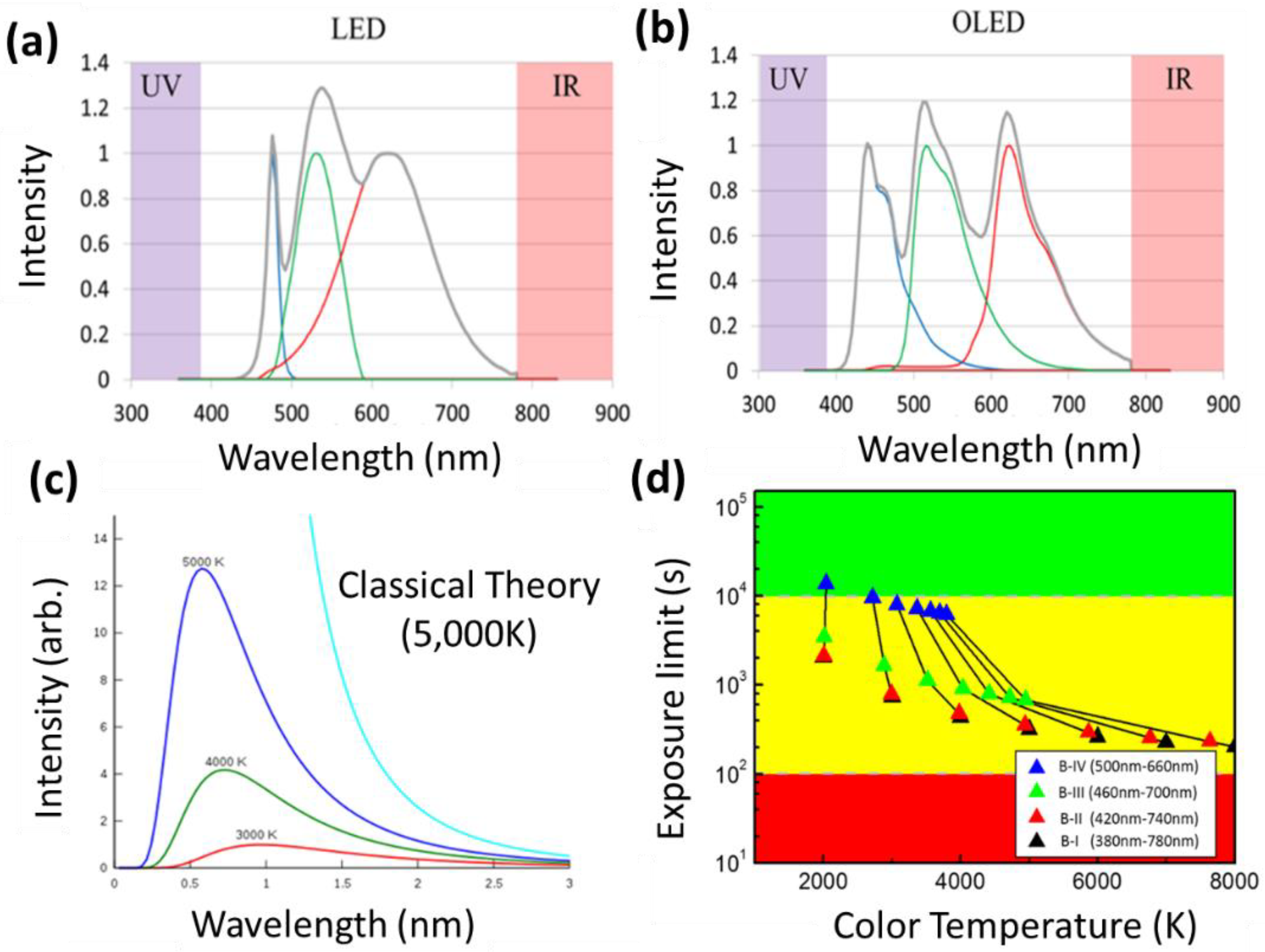
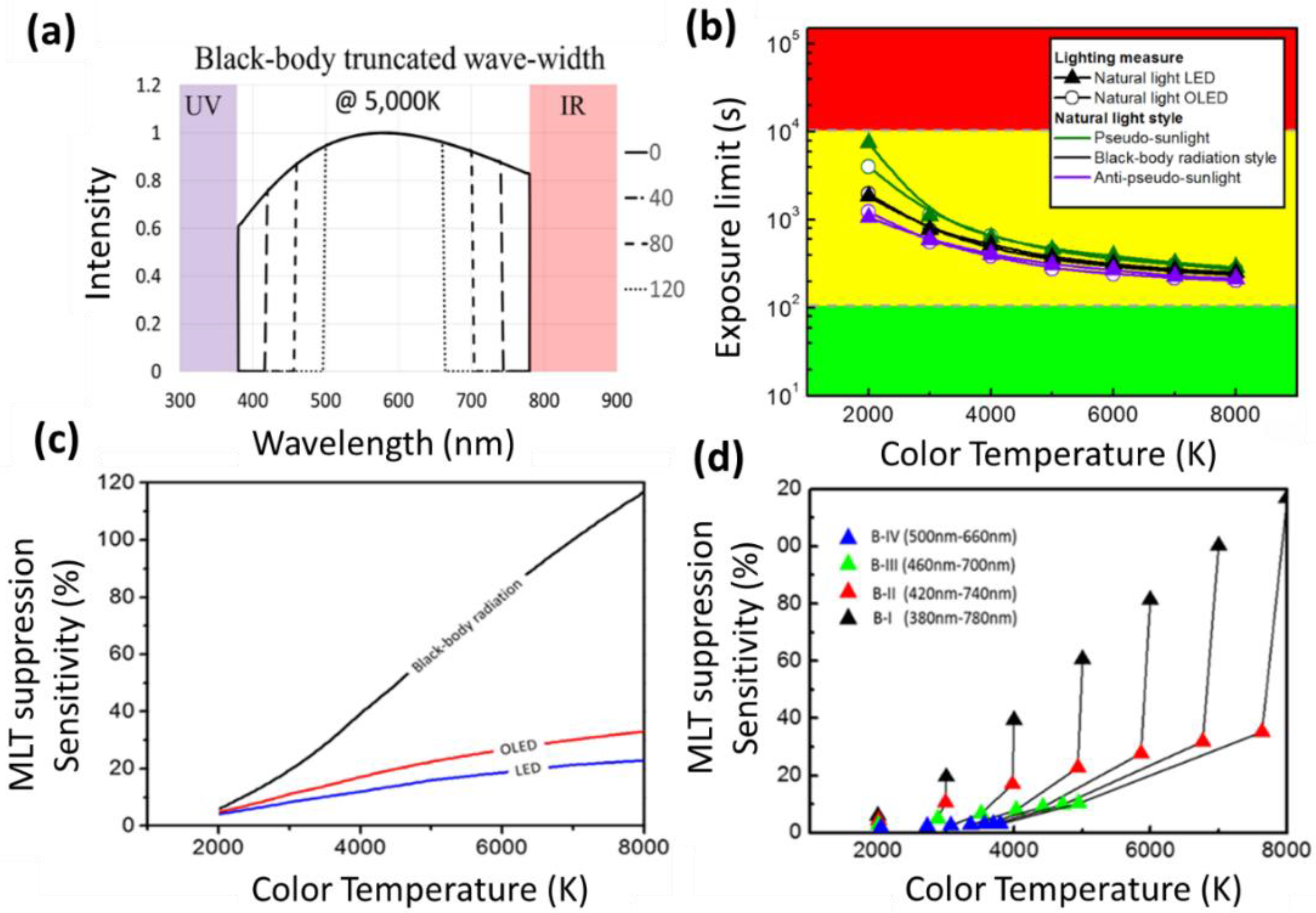
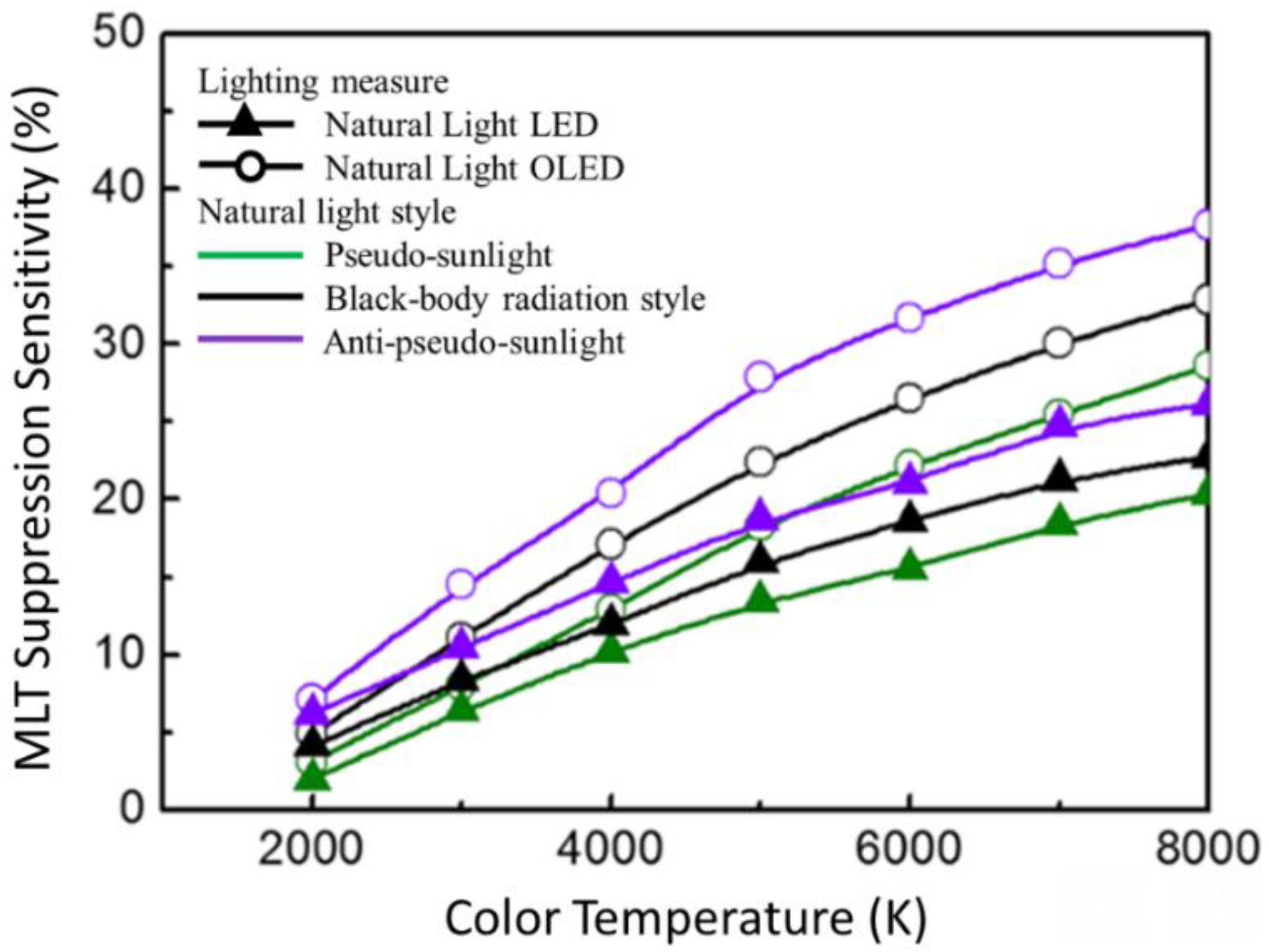
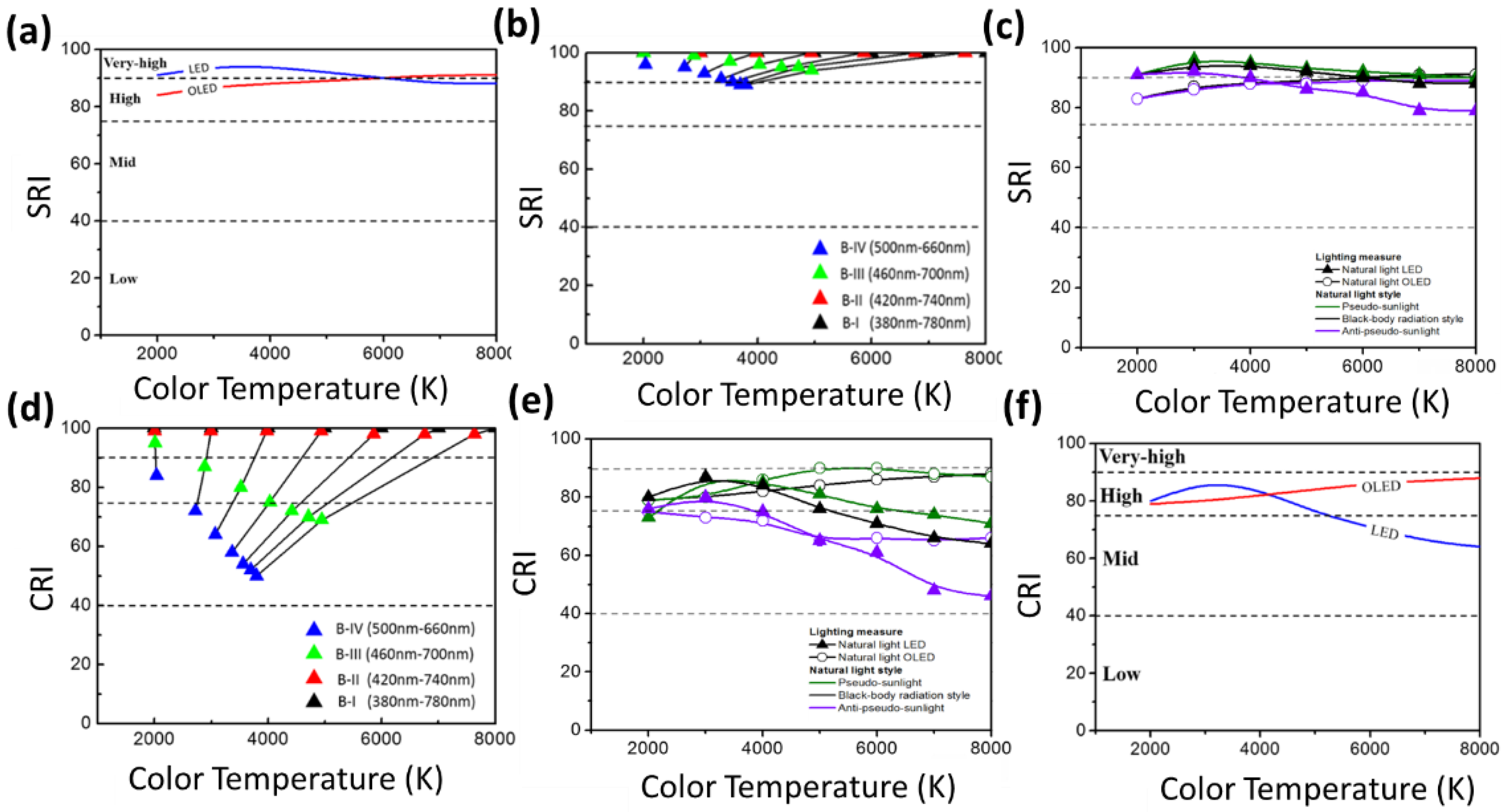
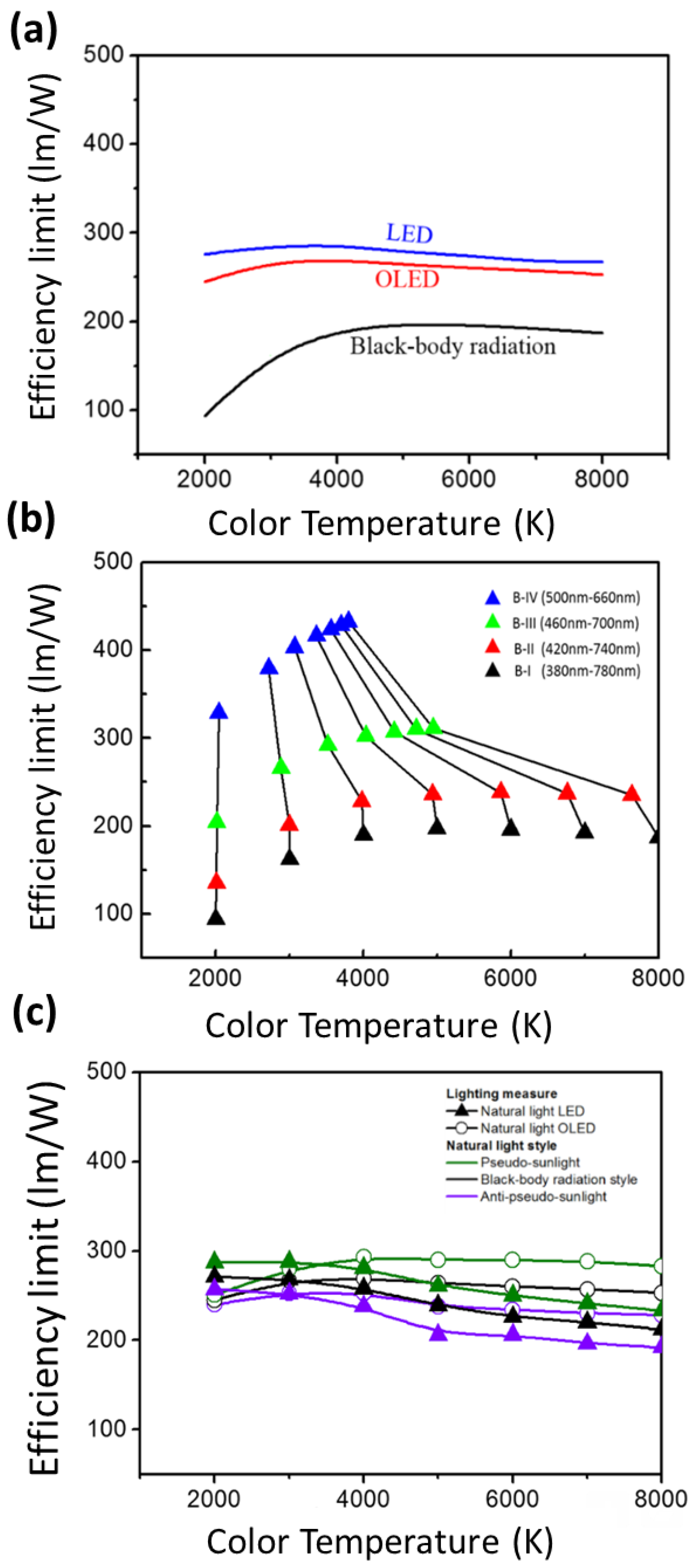
Publisher’s Note: MDPI stays neutral with regard to jurisdictional claims in published maps and institutional affiliations. |
© 2022 by the authors. Licensee MDPI, Basel, Switzerland. This article is an open access article distributed under the terms and conditions of the Creative Commons Attribution (CC BY) license (https://creativecommons.org/licenses/by/4.0/).
Share and Cite
Jou, J.-H.; He, Z.-K.; Dubey, D.K.; Tsai, Y.-F.; Sahoo, S.; Su, Y.-T.; Wu, C.-H. Approach for Designing Human-Centered and Energy Saving Lighting Luminaires. Photonics 2022, 9, 726. https://doi.org/10.3390/photonics9100726
Jou J-H, He Z-K, Dubey DK, Tsai Y-F, Sahoo S, Su Y-T, Wu C-H. Approach for Designing Human-Centered and Energy Saving Lighting Luminaires. Photonics. 2022; 9(10):726. https://doi.org/10.3390/photonics9100726
Chicago/Turabian StyleJou, Jwo-Huei, Zhe-Kai He, Deepak Kumar Dubey, Yi-Fang Tsai, Snehasis Sahoo, Yu-Ting Su, and Chun-Hua Wu. 2022. "Approach for Designing Human-Centered and Energy Saving Lighting Luminaires" Photonics 9, no. 10: 726. https://doi.org/10.3390/photonics9100726
APA StyleJou, J.-H., He, Z.-K., Dubey, D. K., Tsai, Y.-F., Sahoo, S., Su, Y.-T., & Wu, C.-H. (2022). Approach for Designing Human-Centered and Energy Saving Lighting Luminaires. Photonics, 9(10), 726. https://doi.org/10.3390/photonics9100726





